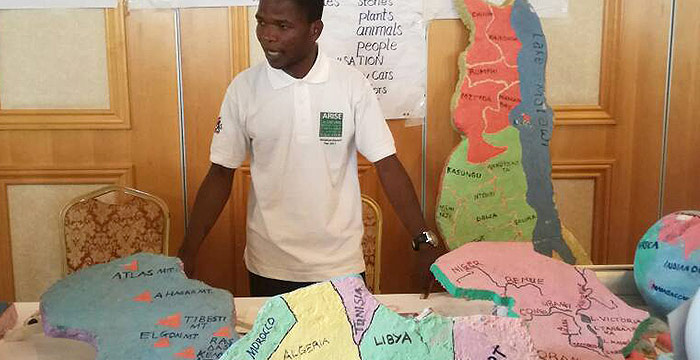
Malawi, Africa
Resource training boosts learning
Teachers learn to create visual aids
ARISE provides teachers with a support program that equips them with a diverse range of skills. The training at Njoka Primary School taught teachers how to create visual aids from waste paper. It has resulted in more engaging lessons and increased student attendance.
When Benard Macheso joined the teaching staff at Njoka Primary School in 2007, he said teaching was difficult because the school did not have adequate teaching and learning resources. “The teaching and learning situation was pathetic and the delivery of lessons was difficult as most lessons required visual aids for teaching. No wonder the perfomance of most of our learners was poor”, he said. According to Benard, teachers were sometimes absent from their duties if they had to teach a subject that required resources and visual aids . It meant that most of the teachers did not teach all of the necessary topics and many would become demotivated. They would ask the Headteacher for the resources but would repeatedly hear in response that the school could not afford them. Unsurprisingly, student performance suffered and each academic year only 9% of the graduating class were selected for secondary school.
With financial support from ARISE partner JTI, the Teacher Support Program (TSP) was introdcued to complement ARISE activities. In 2014 the TSP undertook a detailed asssesment to ascertain the technical needs of teachers. The results revealed a critical lack of teaching and learning materials in the schools, and an improvement plan was developed. The Teaching and Learning Using Locally Available Resources (TALULAR) method was introduced, which promotes the production of teaching and learning resources from waste paper. Some 398 teachers have already been trained to produce their own visual teaching aids such as maps, abacuses, skeletons and counters. The colorful visual resources allow learners to better visualize and recall information, and attendance has also significantly improved. Teachers have also been trained in Effective Classroom Practice, Instructional Leadership, Training Needs Assessment and Identification, and Training Facilitation Skills.
“Before the training, I didn’t know that waste paper could be used to produce teaching, learning, and assessment materials” said Benard. “We’re now delivering our lessons well. Pupils are fully understanding the content and are enjoying the lessons. Teachers are more motivated to teach”, he added.
Benard’s Grade 3 class register also demonstrates an increased attendance rate from 71% to 96%. Numbers of those continuing into secondary school have also risen. “Ever since we started producing the materials, we’ve managed to achieve a 47% selection to secondary school, up from the previous average of 9%”, said Benard. Joyce Dziwapo, Primary Education Advisor (PEA) for the area concurs with Benard regarding the increase in attendance and improvement of learners’ performance. According to Dziwapo, teachers are now better able to cover all content of the syllabus due to the availability of the visual aids.

Learning materials can help teachers deliver lessons more effectively
Other nearby schools have also started to show an interest in the visual aids. “A number of schools have approached us to buy some of the materials, and we are planning to sell them some and use the funds for our own School Improvement Plan (SIP).”




